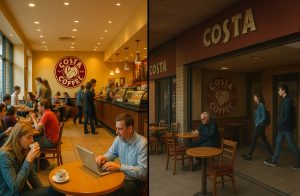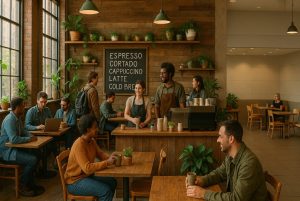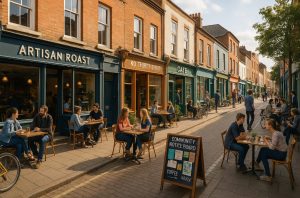In a major shakeup of the UK’s coffee market, Costa Coffee the beloved brand once heralded as Britain’s caffeine king finds itself at a crossroads.
The once-thriving chain, now owned by Coca-Cola, has witnessed a dramatic decline, prompting a larger discussion about the state of coffee culture, the dominance of global chains, and the consumer’s role in shaping the high street. As Costa falters, Starbucks stands next in line for scrutiny.
How Did Costa Coffee Go From Market Leader to a Struggling Brand?

Costa Coffee was once the undisputed leader of Britain’s branded coffee scene. From humble beginnings to a multi-billion-pound acquisition by Coca-Cola, its story is both aspirational and cautionary.
Understanding how such a giant lost its footing requires a closer look at its rapid expansion, changing consumer behaviour, and broader market shifts.
The Rise of Costa: From Roastery to National Chain
Founded in 1971 by Sergio and Bruno Costa, the brand originally focused on supplying roasted coffee to businesses.
By 1981, Costa opened its first store in London, offering the public a taste of what was then considered high-quality Italian-style coffee.
Whitbread’s acquisition of Costa in 1995 for £19 million marked the beginning of an aggressive growth phase. Over the next two decades, the number of outlets exploded:
- 39 stores in 1995
- Over 2,400 in the UK by 2018
- More than 1,400 locations internationally
- 8,000 Costa Express vending machines
Costa quickly became synonymous with grab-and-go caffeine, outpacing rivals in the UK and setting its sights globally.
Coca-Cola’s Ambitious Acquisition Strategy
In 2018, Coca-Cola acquired Costa Coffee from Whitbread for $3.9 billion. It was Coca-Cola’s first step into hot beverages, a sector it had long avoided.
The acquisition aimed to diversify its portfolio and challenge Nestlé’s grip on global coffee via its deal with Starbucks.
The move was logical on paper. Coca-Cola could leverage its vast distribution network to globalise the Costa brand.
But retail coffee is not the same as bottled drinks. It requires real estate, labour, and consistent consumer engagement elements Coca-Cola underestimated.
The Tipping Point: Performance Drops and Missed Expectations
Seven years after the acquisition, the cracks are now visible. Coca-Cola reported a 3% global decrease in coffee sales, attributing the dip largely to Costa’s performance in the UK. CEO James Quincey acknowledged the brand had not met their investment expectations and confirmed that the company was exploring options to offload Costa.
Several underlying factors contributed to this downturn:
- A saturated UK market already dominated by multiple chains and growing independent players
- A product portfolio too reliant on indulgent, high-calorie drinks
- Operational challenges like rising labour, energy, and material costs
- Shifting consumer preferences towards quality, health-conscious choices, and local businesses
The Brand Identity Crisis
As consumer behaviour evolved, Costa failed to redefine its identity. The brand, once associated with rich coffee and comfortable spaces, became more corporate and less connected to café culture. The expansion of Costa Express machines into every petrol station and supermarket may have improved visibility but diminished the brand’s premium appeal.
Even regular customers began to question whether Costa was still serving what they would consider “real coffee” especially when faced with drinks like the Tropical Mango Bubble Frappé or Tiramisu Whipped Latte.
In short, Costa tried to be everywhere, but in doing so, lost sight of who it was.
What Went Wrong with Coca-Cola’s Investment in Costa?
Coca-Cola’s acquisition of Costa was its first major push into hot beverages, an area it had largely avoided in the past.
Initially, the decision was welcomed by market analysts as a smart diversification away from sugary carbonated drinks, whose popularity had been declining.
The problem arose when Coca-Cola underestimated the complexity of operating a retail coffee business.
Unlike bottled drinks, coffee shops rely on real estate, labour, and localised branding, all of which require close attention and adaptability. Costa’s structure, while vast, was not as agile as needed in a rapidly evolving market.
James Quincey, the CEO of Coca-Cola, acknowledged the underperformance publicly. He explained that the investment had not delivered the expected returns and admitted that the company was reconsidering its strategy for Costa.
This has led to speculation that Coca-Cola may sell Costa, potentially incurring a near £2 billion loss compared to its original purchase price.
A number of challenges emerged that Coca-Cola perhaps didn’t anticipate:
- Increasing labour costs due to changes in National Insurance
- Higher raw material and energy prices
- Declining consumer demand for processed, high-calorie drinks
- Growing backlash against global corporate chains in favour of local alternatives
Costa’s core offerings also failed to keep pace with changing trends. Drinks like Mango Bubble Frappés and sugary seasonal lattes no longer appeal to a large segment of consumers who are seeking cleaner, simpler options.
Is the UK Coffee Market Changing for Good?

The UK coffee landscape has transformed considerably over the past five years. Where branded chains once dominated through convenience and scale, consumer tastes have begun to shift.
Many Britons are now seeking more authentic and health-conscious experiences, placing a greater value on taste, sustainability, and local character.
Younger generations in particular are driving this shift. Gen Z and millennials tend to avoid sugar-laden beverages, instead opting for drinks such as:
- Black coffee
- Cold brew
- Espresso-based drinks like cortados and flat whites
There’s also been a notable rise in demand for plant-based alternatives, ethically sourced beans, and compostable packaging.
Large chains like Costa, often slow to adapt due to their size and standardised operations, have struggled to keep up.
In comparison, independent coffee shops offer bespoke menus, locally sourced produce, and personal service qualities that many customers are increasingly seeking.
Changing Coffee Preferences in the UK
| Preference | 2015 | 2020 | 2025 (Est.) |
| Sugar-heavy drinks | 52% | 38% | 25% |
| Black/unsweetened coffee | 21% | 31% | 40% |
| Plant-based milk options | 14% | 29% | 45% |
| Preference for independents | 28% | 42% | 55% |
Costa’s inability to meet these evolving preferences has contributed to its fall from favour.
Why Are Big Coffee Chains Like Costa and Starbucks Losing Their Grip?
The dominance of big coffee chains like Costa and Starbucks is no longer guaranteed. While these brands were built on convenience, global branding, and consistent offerings, their approach is now facing resistance from a more discerning and conscious consumer base.
The Oversaturation of the Market
One of the most significant problems for big chains is overexposure. Costa and Starbucks can be found on nearly every UK high street, in supermarkets, petrol stations, shopping centres, airports, and even hospitals.
This ubiquity has led to a loss of uniqueness. Coffee, which was once seen as a luxury or indulgent experience, has become a generic transaction.
With Costa Express machines available at every corner, the brand experience is diluted. Starbucks, too, has been accused of prioritising speed and brand uniformity over quality.
Health-Conscious Consumers Are Turning Away
Modern consumers are more health-conscious than ever. The ultra-sweet, calorie-dense drinks offered by chains are increasingly out of sync with customer preferences.
Drinks like syrup-filled frappés and whipped cream-topped lattes are now seen as dessert items rather than beverages.
This shift is driven largely by:
- Increased awareness of sugar consumption and its health risks
- Government health campaigns and labelling regulations
- Rising interest in low-calorie and plant-based alternatives
Chains that built their reputations on indulgence now find themselves struggling to stay relevant without alienating their core base.
Brand Fatigue and the Desire for Authenticity
Consumers today crave authentic, personalised experiences. The uniformity of large chains is no longer appealing. Many customers find more satisfaction in independent cafés that offer:
- Locally sourced beans
- Unique interior aesthetics
- Artisan brewing techniques
- Familiarity with baristas and staff
In contrast, walking into a Costa or Starbucks can feel sterile and transactional. What was once comforting in its consistency is now viewed as soulless.
Rising Operational Costs and Lower Margins
It’s not just customer perception hurting these chains. The cost of running a coffee shop has skyrocketed. National Insurance increases, higher minimum wages, and volatile energy and ingredient prices are all squeezing margins.
Large chains with complex supply chains and extensive property portfolios are especially vulnerable. Unlike small independents, they can’t pivot quickly or downsize without shareholder scrutiny.
Additionally, the post-pandemic shift to remote work means fewer commuters buying morning coffees, further impacting revenue from once-reliable city centre outlets.
Product Dilution and Lack of Innovation
Another challenge for these chains is a lack of meaningful innovation. Seasonal flavours and colourful new drinks may garner attention, but they rarely lead to lasting customer loyalty. Many consumers are starting to see through what they describe as “gimmicks.”
Instead, there’s increasing demand for:
- High-quality, single-origin coffee
- Transparent sourcing practices
- More choice in brewing methods (e.g., AeroPress, Chemex, cold brew)
- Honest menus with fewer, better-curated options
Chains that rely heavily on product volume and seasonal novelty struggle to deliver these kinds of experiences.
Can Independent Coffee Shops Save the British High Street?

Independent coffee shops are experiencing a quiet resurgence. These businesses tend to be more in tune with local culture, customer expectations, and environmental concerns. They offer not just coffee but an experience, a sense of place, and often a community hub.
Unlike global chains, independents have the freedom to:
- Curate unique menus
- Offer locally sourced food and drink
- Use sustainable packaging and energy-efficient equipment
- Engage directly with their customer base
These qualities allow them to differentiate in ways that larger chains cannot easily replicate.
Features Comparison – Costa vs. Independents
| Feature | Costa Coffee | Independent Coffee Shops |
| Menu Innovation | Low | High |
| Community Engagement | Limited | Strong |
| Sustainable Practices | Inconsistent | Often Core to Business Model |
| Ambience | Standardised | Unique and Locally Inspired |
| Staff Training & Expertise | Variable | Usually Specialised |
As more customers seek out meaningful coffee experiences, independent cafés are becoming the preferred alternative to chains. Their success could be instrumental in reviving struggling high streets across the UK.
What Should UK Consumers Do Now?
With the spotlight on Costa’s decline and the growing scrutiny on Starbucks, consumers now have more agency than ever. Their spending habits can help shape the future of the coffee industry.
By choosing quality over quantity and supporting independent businesses, consumers can directly influence market trends.
It’s not about rejecting convenience entirely, but about being more mindful of what we consume, where we consume it, and who benefits from our money.
Simple actions consumers can take include:
- Bringing reusable cups to reduce waste
- Ordering simpler coffee drinks with less sugar
- Supporting local businesses through repeat visits and word-of-mouth recommendations
- Asking questions about sourcing and sustainability
These decisions, though small on their own, can collectively signal a shift away from the corporatised model that Costa once championed and that Starbucks still represents.
Is This the Perfect Time to Rethink Our Coffee Culture?

The UK’s coffee culture is at a crossroads. As chains like Costa struggle under the weight of poor strategic decisions and changing consumer values, the opportunity arises to reconsider what the industry should look like going forward.
Coffee doesn’t have to be complex, calorie-laden, or expensive. It can be simple, sustainable, and community-driven. For that to happen, both brands and consumers must embrace a model that values substance over style.
A cultural reset is not only possible it’s necessary.
Conclusion
Costa Coffee’s decline is more than a corporate misstep it’s a reflection of a broader cultural awakening. The British public is slowly realising that branded, sugary drinks served in plastic-lined cups are no substitute for the real thing.
As Costa considers a buyer and Coca-Cola licks its wounds, the question remains: will Starbucks follow suit? Or will we, as consumers, finally take the wheel and steer our coffee culture in a better direction?
The answer lies in how we spend, what we demand, and whether we choose to wake up not just with caffeine, but with clarity.
Frequently Asked Questions
What led to Costa Coffee’s financial downfall?
Costa’s decline was caused by over-expansion, shifting consumer preferences, increasing operational costs, and a failure to innovate meaningfully in a changing market.
Is Coca-Cola really selling Costa Coffee?
Yes. Coca-Cola has publicly stated that Costa is underperforming and is reportedly preparing the brand for sale, potentially incurring a £2 billion loss from its original purchase price.
Why are consumers turning away from big coffee chains?
Modern consumers are seeking authenticity, better quality, and sustainability. Large chains often fail to meet these expectations due to their size and profit-driven models.
Are independent coffee shops more sustainable?
Generally, yes. Many independent shops use ethically sourced beans, compostable cups, and energy-efficient equipment, while also promoting local economies.
What are healthier alternatives to chain coffee drinks?
Drinks like cortados, Americanos, or straight black coffee offer rich flavour without added sugar and calories. Avoiding whipped toppings and syrups makes a big difference.
How can I support my local high street café?
Shop there regularly, leave reviews, recommend it to others, and bring your own reusable cup. Small actions make a big impact for local businesses.
Is Starbucks facing similar challenges to Costa?
Yes. While Starbucks remains globally dominant, it has faced criticism in the UK for overpricing, sugary drinks, and lack of local community integration.








